For IT managers, unchecked ad-hoc software purchases can cause shadow IT and security risks, making it vital to implement software asset management best practices. This article will guide you on how to manage and optimize your SaaS applications effectively.
Without a proper strategy, it's easy to lose track of licenses, usage, and compliance requirements. This lack of oversight can lead to wasted resources, unexpected costs, and compliance risks. You might find your organization paying for unused licenses or facing penalties for non-compliance, creating a stressful and inefficient IT environment.
To avoid these pitfalls, it's essential to implement software asset management (SAM) best practices. Here will explore eight best practices that will help you manage your software assets more efficiently, reduce costs, and ensure compliance. By following these guidelines, you can streamline your IT operations and maintain control over your software assets.
But before that, let's explore the challenges of managing software assets.
Software Asset Management Challenges
Managing software assets comes with several challenges that IT managers must navigate to ensure efficient operations and compliance. Here are some of the key challenges:
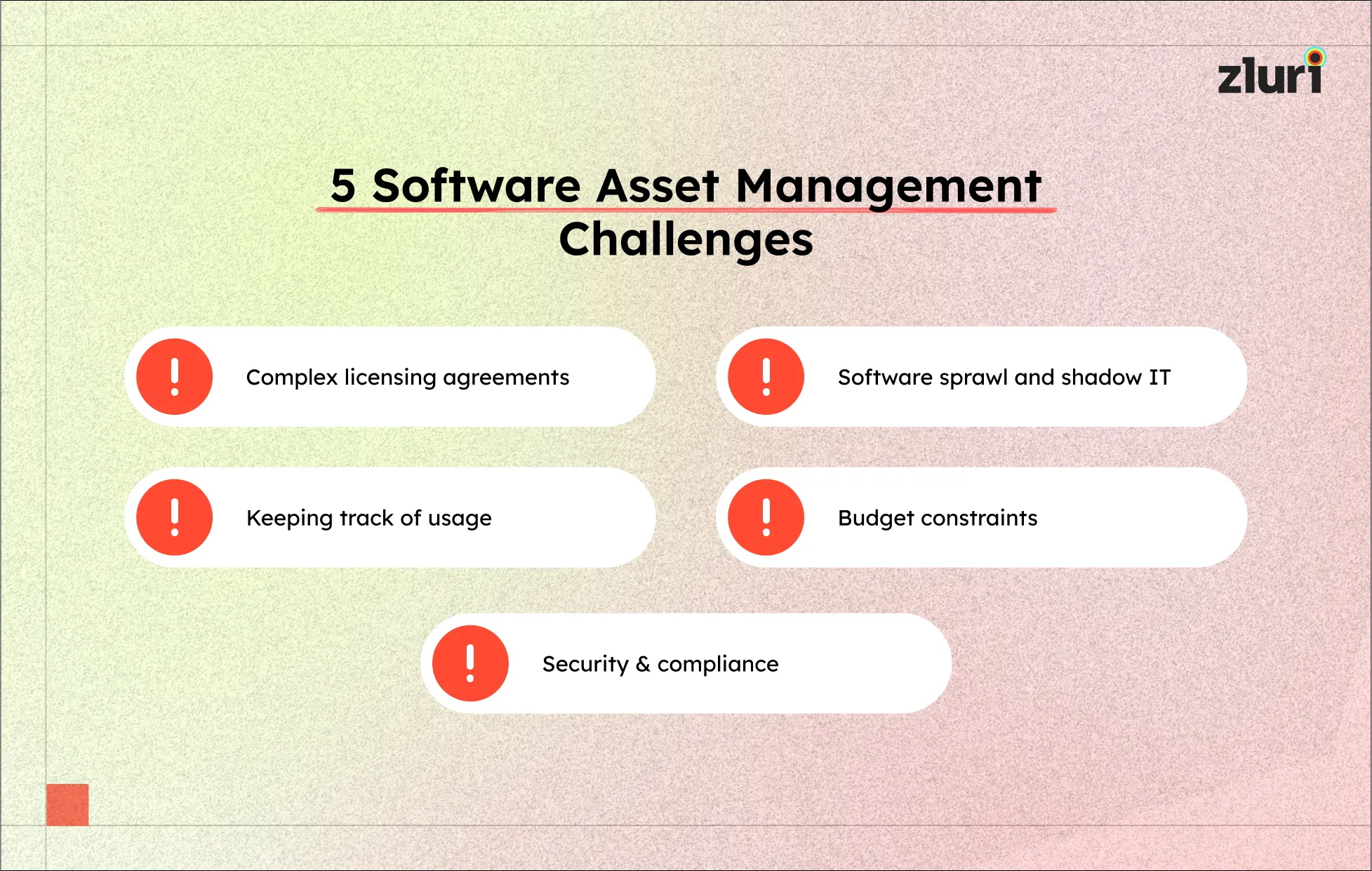
- Complex Licensing Agreements
One of the primary challenges in software asset management is dealing with complex licensing agreements. Different vendors have different licensing models, and keeping track of these variations can be difficult. Misunderstanding or overlooking the details of these agreements can lead to compliance issues and unexpected costs.
- Software sprawl and shadow IT
One major challenge in software asset management is dealing with software sprawl. Over time, organizations tend to accumulate many software applications, many of which may be redundant or underutilized. This can lead to inefficiencies and make tracking software usage and compliance harder.
Additionally, shadow IT, where employees use software without IT department knowledge or approval, can introduce security risks, inefficiencies, and increased costs. Unapproved software can create vulnerabilities in the organization's IT infrastructure and lead to compliance violations.
- Keeping Track of Usage
Another challenge is accurately tracking how software is used across the organization. Without proper monitoring, it's easy to lose track of licenses that are being underused or overused. This can result in paying for more licenses than needed or needing more licenses to meet demand.
- Budget Constraints
Balancing the need for essential software with budget constraints is a constant challenge. IT managers must ensure they get the best value for their investments while avoiding unnecessary expenditures. This requires careful planning and negotiation with vendors.
- Security and Compliance
Ensuring that all software complies with security standards and regulatory requirements is critical. Non-compliance can result in severe penalties and data breaches. IT managers must regularly audit software usage and ensure that all applications are up-to-date with the latest security patches and compliant with relevant regulations.
Learning the best practices for software asset management is important for overcoming the above-mentioned challenges. Let's discuss them in detail.
7 Best Practices To Effectively Manage Your Organization's Software Assets
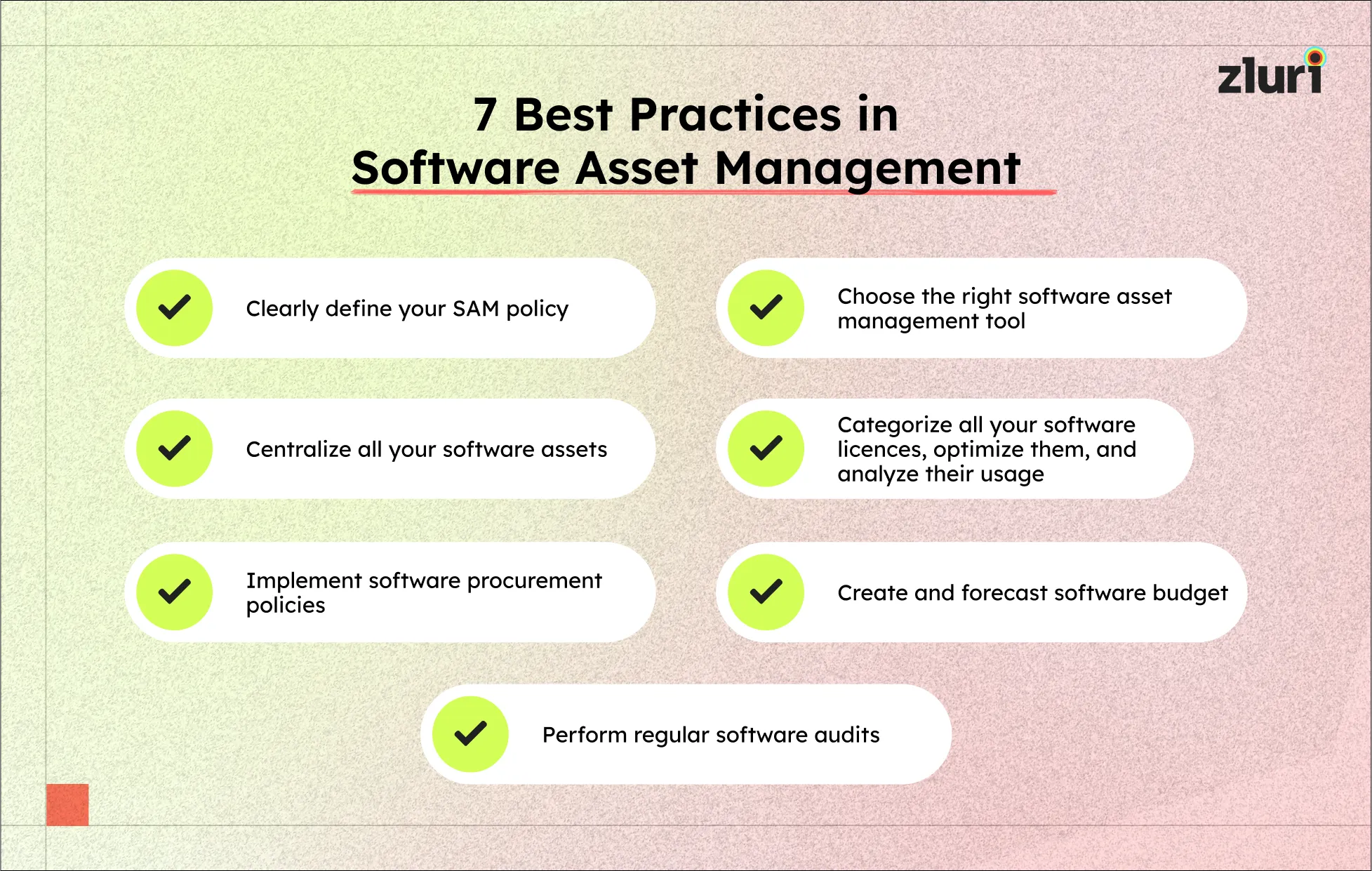
Organizations need to prioritize the adoption of top-tier methodologies to integrate SAM into their operational frameworks. But what strategies need to be implemented? Below, we present you a list of key best practices for software asset management that your team can implement to manage your software assets effectively:
1. Clearly define your software asset management Policy

A well-defined SAM strategy is a crucial software asset management best practice. It helps establish rules for managing software assets and provides a baseline to monitor the program's performance. Additionally, it aids companies in complying with license agreements, preventing legal and financial penalties.
Before starting a SAM initiative, defining your key objectives and goals is essential. These might include ensuring sufficient software licenses, saving money, or handling software vendor audits more efficiently.
Software asset management best practices can become complex and ineffective without clear goals. To ensure a comprehensive approach, all stakeholders, especially IT, procurement, and legal teams, should be involved in creating the SAM policy. Also, consider any industry-specific regulations or compliance requirements.
When developing the policy, it's important to identify and prioritize key processes. Focus on software consumption, purchasing, implementation, personnel movement, and licensing compliance. Each process is vital for managing software assets and maintaining compliance with licensing agreements.
2. Select the suitable software asset management tool
Many companies are still using legacy on-premise software to manage software assets. However, these tools cannot generate real-time reports and need analytics features to generate meaningful insights. So, to streamline your software asset management process, you need to opt for a modern platform.
However, multiple applications are available in the market, so to select the suitable SAM tool, you, as an IT manager, need to visualize business needs and how this tool will help your IT team manage the apps effectively.
One such SAM tool that truly stands out and offers your team the above-mandatory features is Zluri. Zluri is a modern SaaS management platform designed to provide your IT team with complete visibility into your organization's SaaS ecosystem.
Its advanced data discovery engine uses 9 discovery methods: MDMs, IDPs, and SSO, direct integration with apps, finance and expense management systems, CASBs, HRMS, directories, desktop agents (optional), and browser extensions (optional); eliminating the need for manual app identification. This enables your team to discover the apps used in your organization effortlessly.
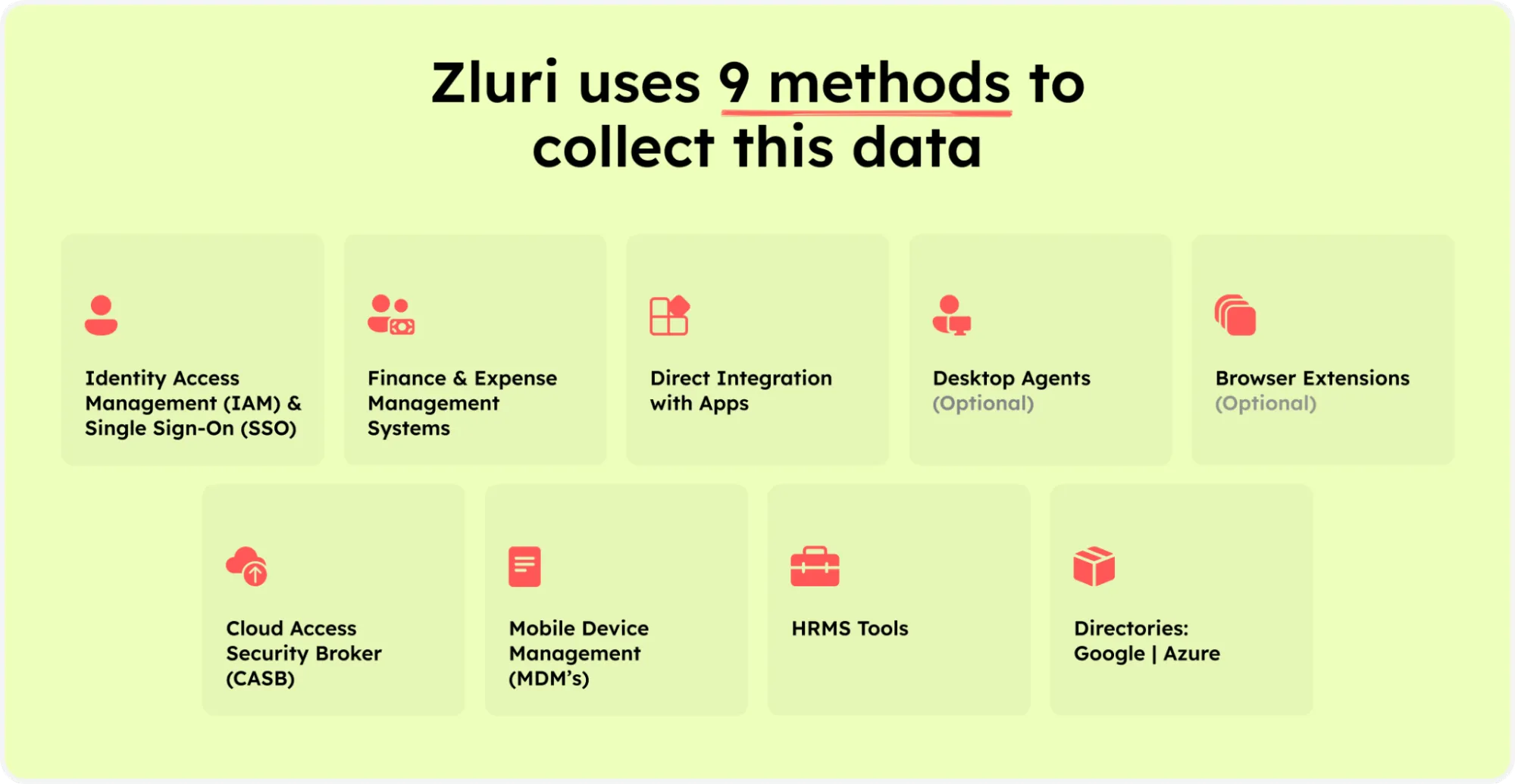
Zluri’s nine discovery methods
Once discovered, Zluri helps you view your SaaS applications' information, including usage statistics, user profiles, underutilized licenses, unauthorized apps, and more.In the image below, you can see the usage statistics of all your SaaS stacks from Zluri.
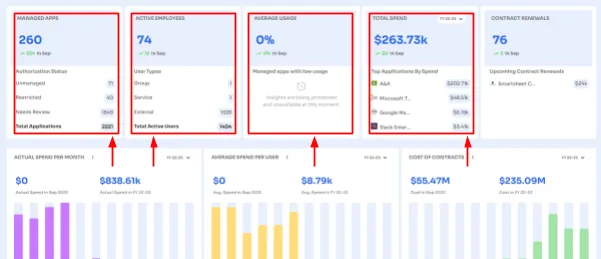
SaaS Apps Overview
Furthermore, by discovering SaaS apps within your organization, Zluri helps your IT team eliminate shadow IT. It also facilitates efficient SaaS license management, reducing SaaS expenditures.
Zluri goes a step further by automatically generating timely reports. This allows your IT team to swiftly detect and address any unauthorized access attempts, preventing security breaches.
One of Zluri's strengths is its seamless integration with over 300 applications, simplifying the acquisition of curated SaaS app data. Also, Zluri is a flexible and scalable solution that aligns perfectly with your IT requirements, enabling them to streamline software asset management processes.
Now, let's look into some of the key features of Zluri:
- Zluri displays all the app spend-related details in a centralized dashboard, including actual costs, year-to-date spending, and more. Also, it provides your IT team with hidden charges or true-up costs, i.e., the difference between the cost that comes from the contract and the actual expenditure.
In the image below, you can see all your app spend-related details in Zluri’s centralized dashboard.
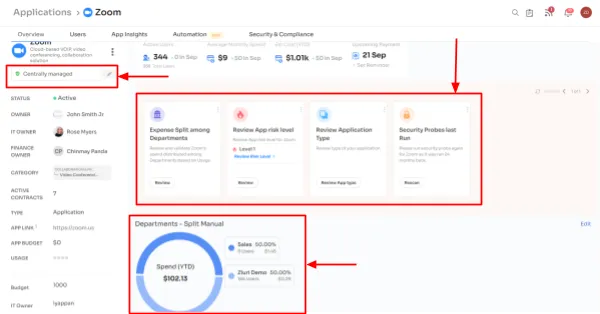
App Insights
- It also effectively identifies redundant applications and promptly flags them for termination.
- Additionally, when applications go unused for a significant period, Zluri sends notifications to your team, enabling them to reallocate licenses or remove them entirely.
In the image below, you can see how Zluri sends notifications to your team about the unused applications and increases savings on your SaaS stack.

Notifications for App Activity
- Furthermore, Zluri offers proactive alerts regarding upcoming renewals, giving your team the necessary time to determine whether rightsizing licenses, maintaining the existing plan, or suspending it is the most prudent course of action.
Now that you know how Zluri helps your IT team streamline the software asset management process, why not book a demo? Experience firsthand how this solution can be a game-changer in efficiently managing your assets.
3. Centralize all your software assets

After selecting the right SAM solution, leveraging its features to identify and centralize your software assets is crucial.
SAM software helps discover installed applications, licenses, contracts, and related documents, consolidating them in one central location. This ensures an accurate and complete inventory of your software assets.
Here are some benefits of centralizing your software assets:
- Efficient Management: A centralized repository makes it easier to track, monitor, and manage software assets, providing a comprehensive view for better decision-making and resource allocation.
- Improved Compliance: Centralizing software assets helps comply with licensing agreements and regulatory requirements by quickly identifying and fixing issues, such as illegal software installations or expired licenses.
- Enhanced Cost Control: With a comprehensive overview of your software assets, you can identify duplicate or underused programs, optimize software usage, save money through license reallocation, and avoid unnecessary purchases.
- Streamlined Processes: Centralizing software assets simplifies procurement, deployment, and maintenance processes. It promotes coordination among software management teams and ensures consistency across the enterprise.
4. Categorize all your software licenses and analyze their usage
Categorizing software licenses and analyzing their usage is essential in software asset management best practices. This software asset management best practice clearly explains the types and quantities of licenses your organization holds.
By organizing licenses into categories, such as by vendor, version, or usage rights, you can easily track and manage them. This reduces the risk of over-purchasing or under-utilizing licenses, which can lead to significant cost savings.
Analyzing software usage is equally important. You can identify patterns and trends by monitoring how and when software is used. This information helps determine if certain licenses are being underused or if additional licenses are needed for high-demand applications.
Moreover, understanding usage patterns ensures that your organization is not paying for more licenses than necessary and that employees can access the tools they need.
Implementing this SAM best practice helps optimize software licenses in several ways.
- It improves financial efficiency by eliminating waste. You can reallocate underused licenses to departments that need them, avoiding unnecessary purchases.
- It enhances compliance by ensuring that all software use aligns with license agreements, reducing the risk of legal issues and fines.
- It supports better planning and budgeting for future software needs, making your IT investments more strategic.
5. Implement software procurement policies
Organizations are now prepared to implement software procurement policies. By completing the previous steps, SAM teams can identify where policies are needed and determine who needs to be involved.
Policies that can be implemented during this stage include vendor lifecycle management policies and SaaS renewal strategies. Vendor lifecycle management policies provide clear guidelines for managing vendor relationships from selection to retirement.
They help ensure consistent performance and value from each vendor. SaaS renewal strategies automate the renewal and update processes, reducing manual efforts and minimizing the risk of missing critical renewals.
Establishing these policies allows organizations to focus on the most significant benefits of their SAM strategy: transformation and value. With clear procurement policies in place, businesses can quickly identify when a software solution is no longer effective. This proactive approach helps prevent overspending from unused or underutilized software. It also reduces the risk of costly audits by ensuring compliance with licensing agreements.
Moreover, well-defined procurement policies streamline decision-making processes. They provide a framework for evaluating software needs and making informed purchasing decisions. This reduces the time and effort spent on procurement and allows teams to focus on strategic initiatives.
6. Create and forecast software budget
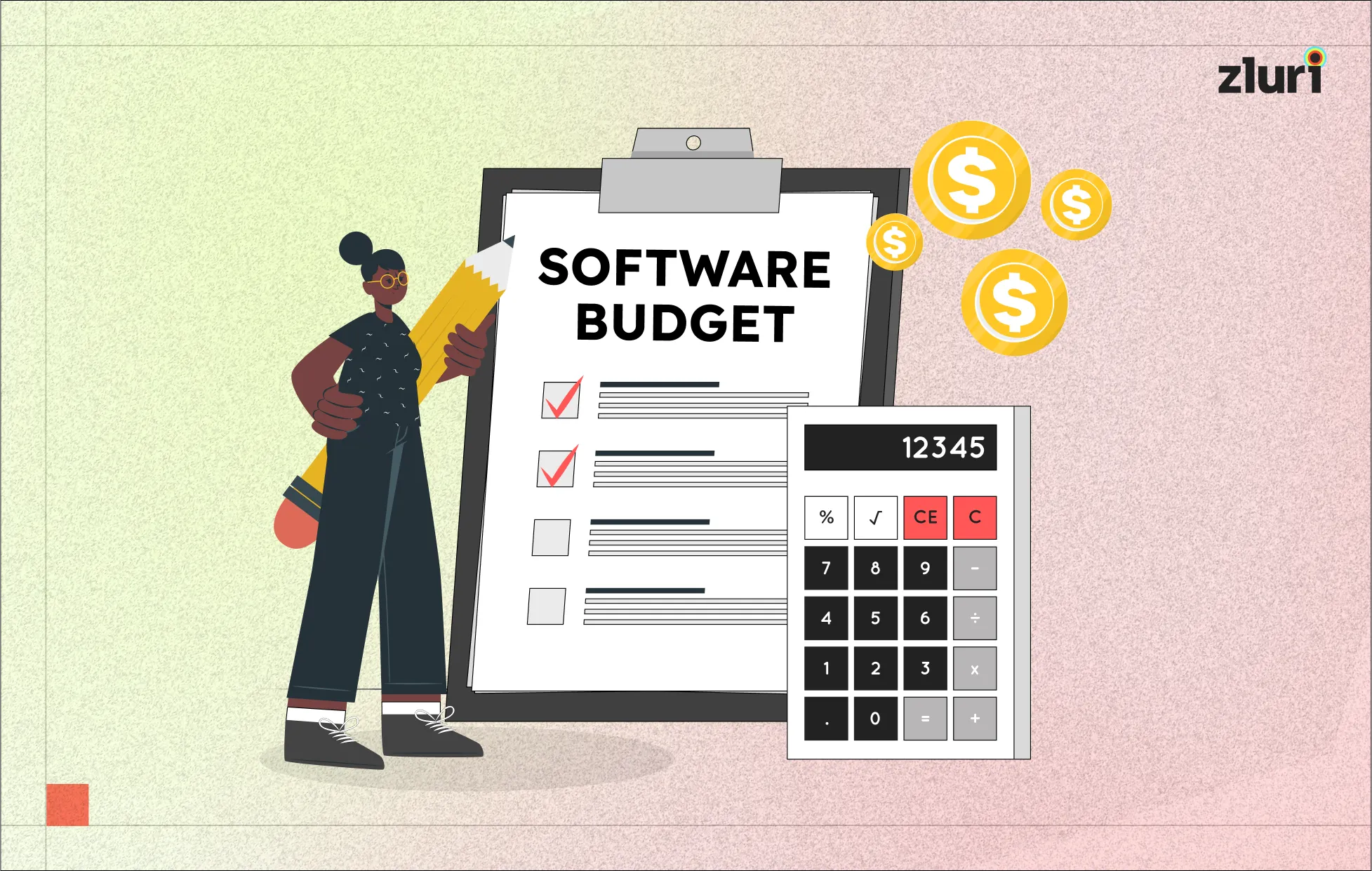
Each practice in software asset management best practices helps companies forecast and establish software budgets as their business evolves.
Wasting money on unused SaaS software is a significant issue for many organizations. However, once a comprehensive SAM process is in place, it becomes easier to identify areas for improvement in both usage and spending. This visibility allows companies to pinpoint inefficiencies and take corrective actions, such as reallocating underused licenses or discontinuing unnecessary subscriptions.
Organizations can make more accurate budget forecasts by continuously analyzing software usage and spending patterns. This proactive approach improves their ability to predict future software needs and allocate resources more effectively. It also reduces waste and ensures that the software budget aligns with actual usage and business goals.
Moreover, a robust SAM strategy helps negotiate better deals with vendors. With clear data on software usage and needs, companies can negotiate more favorable terms and pricing. This contributes to making SaaS solutions more cost-effective.
7. Perform regular software audits

Performing regular software audits is a crucial best practice in Software Asset Management (SAM) that significantly aids in efficiently managing software assets. For an IT manager, this practice ensures that your organization's software usage always aligns with your licensing agreements and business needs.
Regular audits help you maintain an accurate inventory of all your organization's software and SaaS applications. This clear and up-to-date record allows you to identify which licenses are being used, underutilized, and are no longer needed. With this information, you can make informed decisions about reallocating licenses or discontinuing unused subscriptions, leading to significant cost savings.
Audits also play a vital role in compliance. Ensuring that all software usage complies with licensing agreements helps avoid legal issues and financial penalties. Regular audits make your organization audit-ready, reducing the stress and time involved if an external audit occurs. This proactive approach safeguards your organization from unexpected fines and legal complications.
Moreover, regular audits support better financial planning and budgeting. You can accurately forecast future needs by continuously monitoring software usage and avoid over-purchasing licenses. This helps optimize your software budget and ensures that funds are spent effectively.
In addition, audits can reveal opportunities for process improvements. By analyzing audit results, you can identify inefficiencies in software deployment and usage, allowing you to streamline processes and enhance productivity.
Mastering Software Asset Management for IT Success
Implementing best practices in software asset management is essential for IT managers aiming to optimize software investments and ensure smooth operations. Organizations can achieve significant cost savings and compliance by establishing a clear SAM strategy, categorizing and analyzing software licenses, and performing regular audits.
A well-defined SAM process helps manage complex licensing agreements, mitigate risks associated with shadow IT, and control software/SaaS sprawl. It also enables accurate tracking of software usage, effective vendor management, and better financial planning. Additionally, ensuring security and compliance through regular audits and staying adaptable to change are key components of a successful SAM strategy.
These best practices streamline software management and support the organization's overall goals by maximizing the value of software assets. For IT managers, adhering to these practices means more efficient resource allocation, reduced non-compliance risk, and enhanced enterprise productivity.
Frequently Asked Questions (FAQs)
What is software asset management policy?
Software Asset Management (SAM) is an ongoing process with strategic goals that include:
- Negotiating volume contracts: This aims to eliminate or reallocate underutilized software licenses, optimizing the use of resources.
- Collaborating with corporate security and risk teams: This ensures that the organization complies with licensing agreements and security standards, reducing vulnerability to attacks.
By focusing on these goals, SAM helps maintain efficient software usage and enhances overall security.
What is a software asset management framework?
The software asset management framework is a vital supporting document for the Strategic Asset Plan. It serves as a comprehensive model, ensuring all aspects of software asset management life cycle planning are covered. This framework is essential for achieving the vision of delivering safe, secure, and sustainable courts through excellent and expert software asset management.
What is compliance risk in software asset management?
Compliance risk in software asset management refers to the potential for legal and financial consequences if an organization fails to adhere to software licensing agreements and regulations. This risk arises when software is used without proper licenses, when licenses are exceeded, or when terms are not followed correctly.









.svg)














